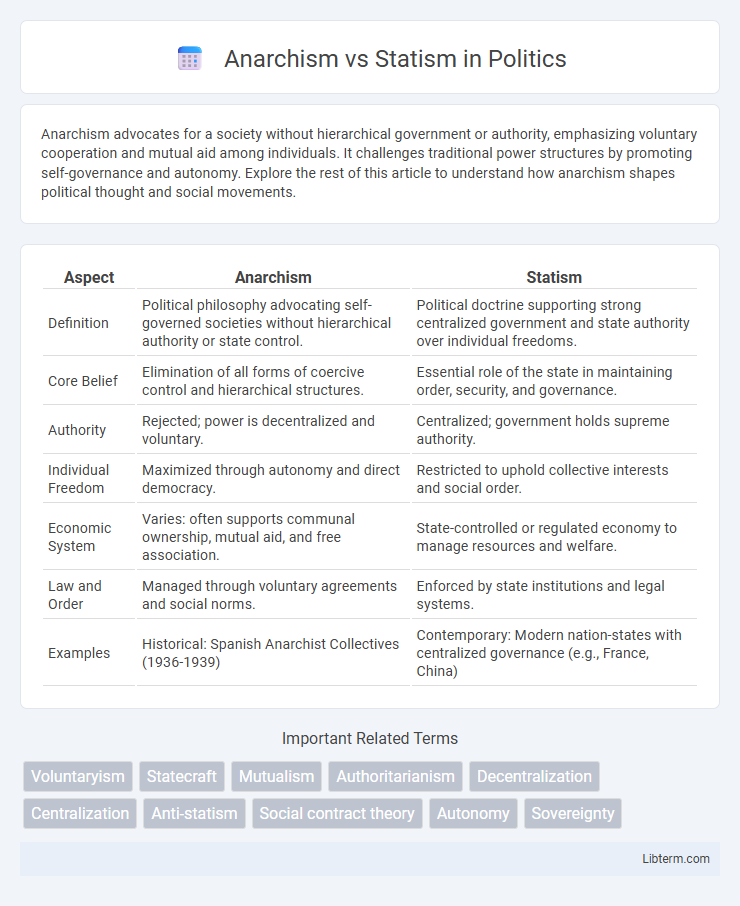Anarchism advocates for a society without hierarchical government or authority, emphasizing voluntary cooperation and mutual aid among individuals. It challenges traditional power structures by promoting self-governance and autonomy. Explore the rest of this article to understand how anarchism shapes political thought and social movements.
Table of Comparison
| Aspect | Anarchism | Statism |
|---|---|---|
| Definition | Political philosophy advocating self-governed societies without hierarchical authority or state control. | Political doctrine supporting strong centralized government and state authority over individual freedoms. |
| Core Belief | Elimination of all forms of coercive control and hierarchical structures. | Essential role of the state in maintaining order, security, and governance. |
| Authority | Rejected; power is decentralized and voluntary. | Centralized; government holds supreme authority. |
| Individual Freedom | Maximized through autonomy and direct democracy. | Restricted to uphold collective interests and social order. |
| Economic System | Varies: often supports communal ownership, mutual aid, and free association. | State-controlled or regulated economy to manage resources and welfare. |
| Law and Order | Managed through voluntary agreements and social norms. | Enforced by state institutions and legal systems. |
| Examples | Historical: Spanish Anarchist Collectives (1936-1939) | Contemporary: Modern nation-states with centralized governance (e.g., France, China) |
Defining Anarchism and Statism
Anarchism advocates for the absence of hierarchical government structures, emphasizing voluntary cooperation and individual autonomy as the foundation of social organization. Statism supports the centralization of authority within a state apparatus, asserting that a governing body is essential to maintain order, enforce laws, and provide public services. The debate between anarchism and statism centers on the role and legitimacy of state power versus the pursuit of self-governance and freedom from coercive institutions.
Historical Origins and Evolution
Anarchism originated in the 19th century as a radical critique of centralized authority, with early theorists like Pierre-Joseph Proudhon and Mikhail Bakunin advocating for a stateless society based on voluntary cooperation. Statism, rooted in ancient civilizations and formalized by political philosophers such as Thomas Hobbes and Jean-Jacques Rousseau, emphasizes the necessity of a centralized state to maintain order and enforce laws. Over time, anarchism evolved through diverse movements including collectivist, mutualist, and anarcho-communist traditions, while statism expanded into various forms like authoritarianism, totalitarianism, and liberal democracy.
Core Philosophical Principles
Anarchism emphasizes the abolition of all hierarchical structures and advocates for self-managed, stateless societies rooted in voluntary cooperation and individual freedom. Statism supports centralized authority and governance through a structured state to maintain order, enforce laws, and provide public services, prioritizing collective security over absolute personal autonomy. The core philosophical divide centers on autonomy and coercion, where anarchism rejects institutional power as inherently oppressive, and statism views it as essential for social organization and stability.
Views on Authority and Governance
Anarchism fundamentally rejects all forms of hierarchical authority and centralized governance, advocating for self-managed, stateless societies based on voluntary cooperation and mutual aid. Statism supports the necessity of a centralized state to maintain order, enforce laws, and provide public services, often emphasizing the legitimacy of sovereign authority to govern populations. The core divide lies in anarchism viewing authority as inherently oppressive, while statism considers structured governance essential for social cohesion and stability.
Economic Systems and Property Rights
Anarchism advocates for the abolition of centralized state control, emphasizing decentralized, cooperative economic systems where property is commonly owned or managed collectively to prevent hierarchical exploitation. Statism supports centralized government authority, enforcing private property rights and regulated markets to maintain order, wealth distribution, and economic stability. The core conflict lies in anarchism's pursuit of egalitarian ownership and statism's endorsement of legal frameworks that protect individual property and economic hierarchy.
Social Order and Security Approaches
Anarchism advocates for the elimination of centralized authority, emphasizing voluntary cooperation and self-governed communities to maintain social order and security. Statism relies on a centralized government and legal frameworks to enforce laws, providing structured authority that ensures public safety and societal stability. The contrast lies in anarchism's trust in decentralized, mutual aid systems versus statism's dependence on institutionalized control and enforcement mechanisms.
Individual Liberty vs Collective Control
Anarchism champions individual liberty by rejecting centralized authority and promoting self-governance, emphasizing personal autonomy and voluntary cooperation. Statism prioritizes collective control through a centralized government that regulates society, aiming to maintain order and provide public goods. The core conflict lies in balancing maximum individual freedoms against the need for societal regulation and unity.
Case Studies: Real-World Examples
Anarchism and statism reveal contrasting governance outcomes in real-world case studies, such as the Spanish Revolution of 1936 where anarchist collectives successfully implemented decentralized self-management amidst civil war. In contrast, statist models like modern China demonstrate centralized authority driving rapid economic growth and social control through state-owned enterprises and strict regulatory frameworks. These examples highlight fundamental differences in political organization, with anarchism prioritizing voluntary cooperation without hierarchical state control, while statism enforces top-down governance and institutional authority.
Criticisms and Common Misconceptions
Anarchism faces criticism for perceived impracticality in maintaining social order and fears of chaos without centralized authority, while statism is often critiqued for potential authoritarianism and suppression of individual freedoms. Common misconceptions about anarchism include the false equation of it with lawlessness or violence, whereas statism is frequently misunderstood as inherently oppressive rather than a diverse spectrum of governance. Both ideologies are subject to debate over the balance between individual liberty and collective control.
Prospects for the Future
Anarchism envisions a society organized through voluntary cooperation and decentralized structures, potentially fostering greater individual freedom and dismantling hierarchical power dynamics. Statism relies on centralized authority to maintain order and provide public services, which may ensure stability and coordinated responses to complex social challenges. Future prospects hinge on balancing autonomy with governance effectiveness, as technological advances and social movements reshape the debate between self-governance and state control.
Anarchism Infographic

 libterm.com
libterm.com